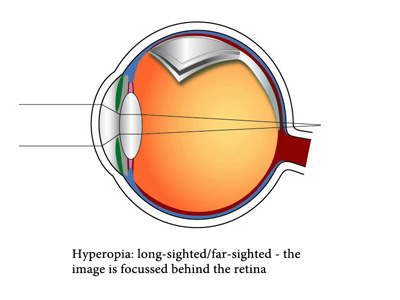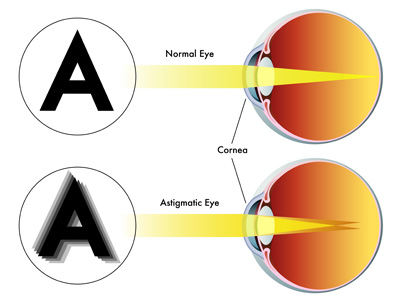We see the world around us because of the way our eyes bend or otherwise refract light. Refractive errors are optical imperfections that prevent the eye from properly focusing light, causing blurred vision. Refractive anomalies often are the main reason a person seeks the services of an optometrist.
If a refractive anomaly is present in one or both eyes, this means that the shape or size of your eye does not bend light correctly. This results in the image not being formed on the retina which is the membrane lining the internal back of the eye. The retina is composed of the sensitive sensory cells responsible for the sense of sight. As a result the image is not being formed on the retina, and is perceived by the brain as blurred. Additional symptoms of refractive anomalies include difficulty in seeing clearly up close, headaches, fatigue, eyestrain and even crossing of the eyes in very young children.
The different types of refractive anomalies are:
- Myopia (Shortsighness, Nearsightness)
- Hypermetropia/hyperopia (Longsightness, Farsightness)
- Astigmatism
- Presbyopia
1. Myopia
Myopia is a very common refractive anomaly affecting almost 30% of the European population. It can be hereditary but can also occur spontaneously. It normally occurs in childhood but can also present later in life. If it occurs in childhood it usually progresses more during puberty. Myopia is a visual condition in which near objects are seen clearly but distant objects do not come into proper focus. In a myopic eye the axial length that is the actual length from the tip of the cornea to the back of the eyeball, is bigger compared to the length of an ideal not myopic eye. As a result of this greater axial length, the light entering the eye, bends and forms the image before the sensory retinal cell layer. This is a larger (compared to the corrected clear image) and blurred image.
If you have myopia, you may need glasses for distance only or full time if your prescription increases to enable you to see clearly. In general, safe driving is our main concern and sharp and comfortable vision is essential for safe driving both during daytime and nighttime.

2. Hypermetropia
Many people have some degree of hyperopia without knowing it. It can be hereditary but can also result from environmental factors. Hyperopia is a refractive anomaly in which distant objects are easier to see than near objects. The axial length of the eyeball is shorter compared to the normal non hyperopic eye and thus the image is formed behind the retinal sensory cell layer. This results in difficulty in maintaining clear focus on near objects, eye strain, fatigue or headaches after close work, aching or burning eyes, weak reading ability or tension. In an individual who is above forty, hyperopia also results in blurred vision in distant objects as well.
This is because the aging eye loses its ability to ‘autocorrect’ and bring the image forward and on to the retina. That is why younger persons with a small degree of hyperopia can identify distant detail with little difficulty. This is also the reason why mild hyperopia, the eyes may be able to compensate adequately without the need of corrective glasses in the distance, although glasses for reading or computer use maybe indicated. For moderate or high prescriptions of hyperopia, glasses or contact lenses may be prescribed for full time wear.

3. Astigmatism
Most people have some degree of astigmatism and slight amounts of it may not require correction with glasses. This refractive anomaly occurs when the cornea (front surface of the eye) or the crystalline lens inside the eye is slightly irregular or cylindrical in shape, resulting in vision being blurred or distorted in all distances. Light is not refracted properly on the sensory retinal layer and because of the differences in the axial length inside the eye, caused by the misalignment of the components of the eye, the end image is not a point image thus is a blurred image. One could say that it is less usual for an individual to have a perfectly round and spherical cornea (and lens) rather than a slightly non-spherical one.
Even mild or moderate degrees of astigmatism cause blurred and distorted vision. This can lead to eyestrain, headaches and fatigue. However, almost all levels of astigmatism can be optically corrected with either glasses or contact lenses. High levels of astigmatism resulting from eye surgery can be usually be corrected with special types of contact lenses. Astigmatism may change with time and as all refractive anomalies is essential to be reviewed by your optometrist at least every two years in adults and every six months in children.

4. Presbyopia
Presbyopia is the refractive anomaly in which the ability to focus on close objects gradually reduces. This happens due to the normal aging change in which the crystalline lens inside the eye, loses its ability to change shape (elasticity and flexibility of its components gradually diminish) in order to focus on near objects. This simply results in an inability to focus on near objects thus making near vision tasks such as reading very difficult.
Although presbyopia may seem to develop suddenly, the actual decline in the ability to focus on near objects takes place gradually. Presbyopia becomes apparent to people in their early to mid- forties,, initially resulting in difficulty reading very fine print up close or in poor lighting. At these initial stages of presbyopia, it will be easier to read this fine print if it is pushed further away from you or if it is seen under good lighting conditions.

Custom made or ready- made readers?
By the mid or late forties, presbyopia reaches a stage in which near objects within an arms’ length, cannot be viewed clearly without the use of reading glasses. The physiological changes in the crystalline lens continue to progress until the mid-fifties resulting in a parallel increase of the amount of presbyopia. In general presbyopia glasses, which are very commonly called readers, need to be reviewed approximately once every two years in order to continue to provide comfortable reading. Do remember that ready -made readers will only provide sufficient near vision, if your distance vision is excellent without glasses. Moreover ready-made readers always have the same lens power in front of both eyes but the two eyes are almost rarely exactly the same. In case you still chose to use ready-made and not custom made readers, be very cautious since the quality of the lenses used in mass production industrial made ready-made readers is often very poor. This poor quality, together with the fact that the lenses have not being glazed according to your own pupil centers can lead to discomfort, headaches and serious eyestrain (pupil centers or pupillary distance: this is a personalized facial feature, is the distance between your own pupil centers and is an important measurement on which any corrective pair of glasses should be made to).



